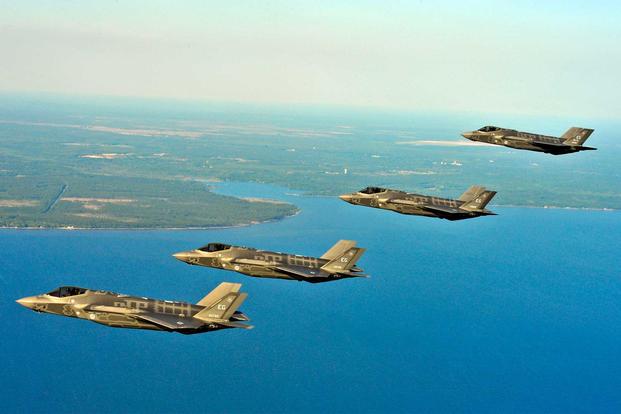The U.S. Air Force's F-35 Joint Strike Fighter fleet has officially surpassed the number of F-15 Eagle jets and A-10 Thunderbolt II attack aircraft, becoming the second largest fighter jet fleet in its aircraft inventory, the service's top general said Friday.
Chief of Staff Gen. Charles "CQ" Brown revealed the new statistic during a hearing about the fiscal 2022 budget before the House Appropriations defense subcommittee. As of this week, he said, the F-35 fighter fleet is second in size only to the F-16 Fighting Falcon; the Air Force has 934 F-16 C and D models.
Air Force spokeswoman Maj. Malinda Singleton told Military.com the service has 283 F-35s, which also surpasses the A-10 Warthog fleet by two aircraft.
Read Next: Army Trainee Accused of Hijacking School Bus Charged with 19 Counts of Kidnapping
During the hearing, Brown discussed how the Air Force plans to move forward with its "TacAir study," which will determine the right mix of aircraft for the future, and assess how future fighter concepts will fit into the current mix of fourth- and fifth-generation fighters.
"It won't necessarily give us an answer, [but] a range of answers to take a look at the threat and make sure we have done the analysis to inform ourselves but also our key stakeholders, which includes this committee," he said.
The F-35 fleet eclipsed the number of F-22 Raptors in 2019 -- with 203 at the end of that fiscal year; the Air Force capped its Raptor fleet at 187 in 2009 (it currently has 186).
According to the Air Force Association's 2020 aircraft almanac, the service has 241 F-15C/D Eagle models and 218 F-15E Strike Eagles.
Brown in February disputed reports calling the F-35 a high-cost Pentagon failure, saying that was "nowhere near the case." In his prepared testimony before the subcommittee Friday, he said the jet remains "the cornerstone of our future fighter force and air superiority."
He told reporters Feb. 17 that the Air Force hasn't ruled out bringing a new fighter jet into its inventory as it looks to replace older, fourth-generation F-16s. This marks a change; since the beginning of the Joint Strike Fighter program, the service had held that older Falcons should be replaced by the fifth-generation Lightning II. Some critics view Brown's comments as foreshadowing the stealth jet's demise.
The Air Force is the largest customer for the F-35 and hopes to procure 1,763 F-35 conventional takeoff and landing A-variants.
But according to Aviation Week, future defense budgets could limit the inventory. The magazine reported in December that the service might cap its total F-35 buy at 1,050 fighters.
The Air Force expects to keep a well-rounded mix of fourth- and fifth-generation aircraft through the 2030s, officials have said.
Last month, the service added the F-15EX Eagle II to its ranks as its new fourth-plus generation fighter.
-- Oriana Pawlyk can be reached at oriana.pawlyk@military.com. Follow her on Twitter at @oriana0214.
Related: Air Force General: Field This Next-Gen Fighter in Time to Beat China












